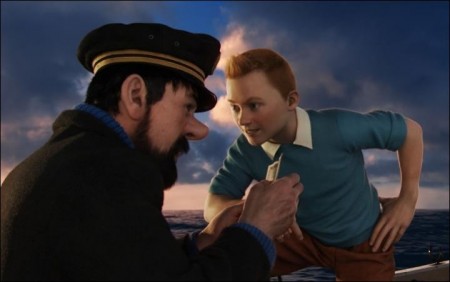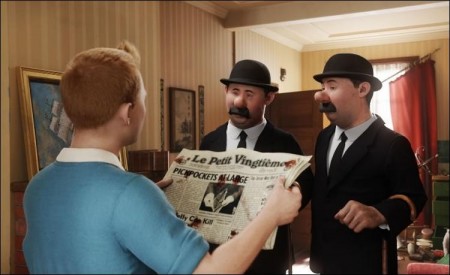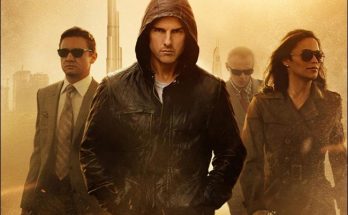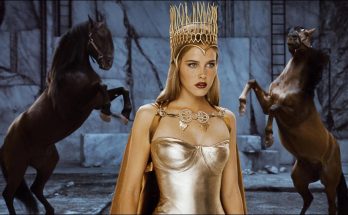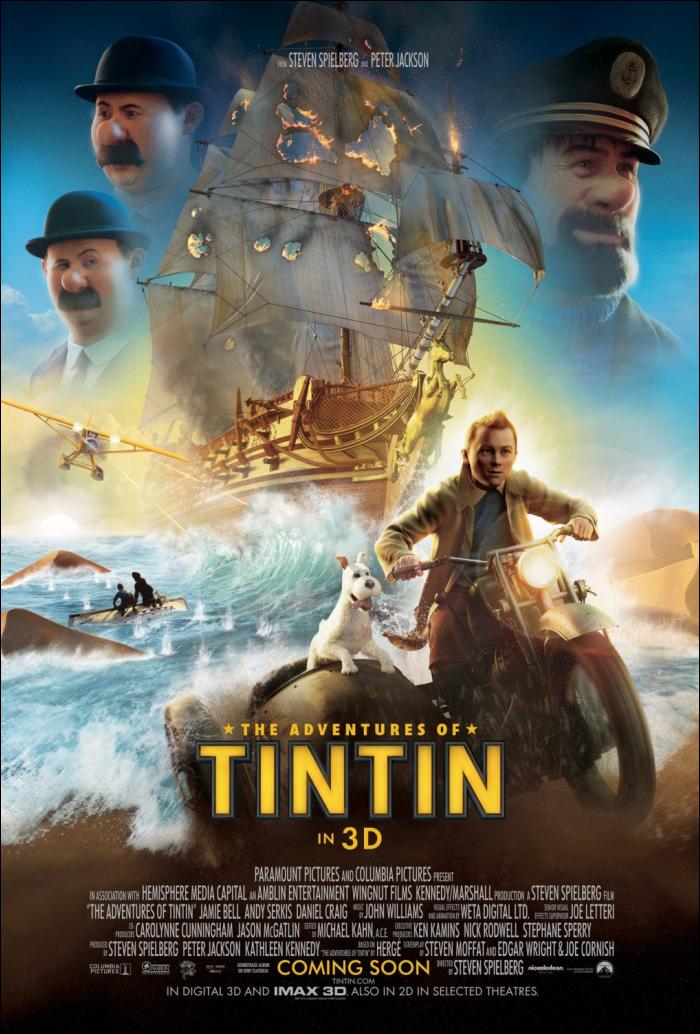Taglines: This year, discover how far adventure will take you.
The story follows the unquenchably curious young reporter Tintin (Jamie Bell) and his fiercely loyal dog Snowy as they discover a model ship carrying an explosive secret. Drawn into a centuries-old mystery, Tintin finds himself in the sightlines of Ivan Ivanovitch Sakharine (Daniel Craig), a diabolical villain who believes Tintin has stolen a priceless treasure tied to dastardly pirate named Red Rackham. But with the help of his dog Snowy, the salty, cantankerous Captain Haddock (Andy Serkis) and the bumbling detectives Thompson & Thomson (Simon Pegg and Nick Frost), Tintin will travel half the world, outwitting and outrunning his enemies in a breathless chase to find the final resting place of The Unicorn, a shipwreck that may hold the key to vast fortune… and a ancient curse.
From the high seas to the sands of North African deserts, every new twist and turn sweeps Tintin and his friends to escalating levels of thrills and peril, proving that when you dare to risk everything, there’s no limit to what you can do.
Designing The World Of Tintin
Steven Spielberg and Peter Jackson share not only fertile imaginations but also a drive to venture into frontier realms. From extra-terrestrials to Middle Earth, they have forged unforgettable characters and worlds so breathtakingly original they could never have been experienced outside a movie theatre. And yet, neither had ever applied their skills and artistry to a 3D animated motion picture.
Spielberg and Jackson’s fealty was first and foremost to the Tintin legacy – and their shared passion for Herge’s transporting drawing style inspired the visual design into a fully animated CG film from day one.
Early on, while the script was still being written, the art department and animation team were set up, and collaborators on both sides of the Pacific began brainstorming ideas for the quirk-filled characters and spicy settings for Tintin. One of the first big decisions they made, one that would inform everything that followed, was to keep the period and texture of the story unmoored in time – set in a kind of eternal noir universe, with dark shadows lurking around every corner.
“These stories could take place in the `30s, the `50s, the `80s or now,” notes Spielberg, “and that’s part of their beauty that we wanted to preserve. What we didn’t want in our movie were cell phones, television sets or modern automobiles. Our design cues came first from Herge, and not from any presumed period or setting.”
Adds Jackson: “We wanted the film to have the retro, edgy feel of a crime drama. That’s not Tintin himself, but the world that Tintin lives in. There’s so much suspense in the story that we felt we could incorporate people with trench coats, hats down in the rain, street lights casting shadows on the wet pavement — that’s the world we’ve created for our Tintin to live in.”
Next, the artists, designers and animators started envisioning what Herge’s art would look like if it existed in three-dimensional space. Despite having been drawn decades ago, the artwork lent itself organically to this, says Richard Taylor, Weta Workshop’s co-owner and the film’s design and effects supervisor. “When you look at Herge’s black pen drawings with watercolor washed in flat on the page, all you have to do is close your eyes and begin to imagine the world of Tintin. You can’t help but see it in 3D,” he muses.
It worked so well in part because Herge had left behind the rules of pure reality when drawing Tintin’s escapades in the first place. “The lines of what Herge drew were not necessarily accurate,” says senior visual effects supervisor Joe Letteri. “He wasn’t trying to draft exactly what he saw – and we wanted to maintain those exaggerated qualities in the same way that he did. A big part of the design study was to look at what he did, but then to imagine it from different points of view. And that allowed us to start building up a vocabulary of how you would construct his worlds in a wholly 3D animated realm.”
To bring Herge’s world alive so audiences can sense the very wind whipping through the virtual air, the art department researched imagery and locations that might represent the various environments where Tintin, Snowy and Haddock find themselves, from the boiling high seas of a stormy ocean to the shifting pink sands of the Sahara Desert. A favorite of the designers was Herge’s imaginary city of Bagghar, Morocco, a seductive realm of Far East intrigue.
“We looked at many different styles of North African structures, patterns and archways,” says conceptual designer Rebekah Tisch, “and were able to use fascinating shapes and colors to create Bagghar. It left me with a real passion to go see the world – and I hope that people watching Tintin will feel that same fusion of excitement and color.”
On an invitation from Fanny and Nick Rodwell of the Herge Foundation, lead conceptual designer Chris Guise traveled to Brussels to conduct close-up research into Tintin’s native locale, soaking in the atmosphere that led to the creation of his apartment at 26 Labrador Road and the silhouette of Captain Haddocks’s country home at Marlinspike Hall.
“Chris immersed himself completely in Herge’s world and looked for his early inspirational images, then came back just bubbling over with a fully rounded sense of place,” remarks Richard Taylor.
Digital model supervisor Marco Revelant further added to the process with his passion for model ships, which are so key to the adventure. Revelant traveled to the Musee de la Marin in Paris to visually dissect the ships on which Herge based the Brilliant and The Unicorn. “Herge’s designs are a bit more elaborate yet reduced in size,” says Revelant. “We applied those same adjustments to our digital models.”
Visual effects art director Kim Sinclair looked high and low for authentic vehicles, such as the 1937 Ford seen in the books that were then scanned into the computer to be re-created digitally. “Herge did some meticulous research into the vehicles, like the Ford and the sea plane, and we were able to know the model and year, and even find the original manufacturer’s color charts,” he explains.
But the most critical design element of all, from the start, was the characters themselves. From Haddock’s humor-spiked poses to the sky-ward texture of Tintin’s hair to the distinguishing shapes of detectives Thompson and Thomson’s moustaches to the emotions crossing Snowy’s snout, every nuance was debated, imagined, re-imagined and then fine-tuned during their intensive meetings.
“We looked at ever character from every angle to make sure they had the Herge facsimile,” Spielberg recounts. “We were never afraid to say, `Well, that particular mold of Captain Haddock’s face doesn’t look like we’re on key with the Herge art.'”
The Adventures of Tintin
Directad by: Steven Spielberg
Starring: Jamie Bell, Andy Serkis, Daniel Craig, Nick Frost, Simon Pegg, Daniel Mays, Gad Elmaleh, Toby Jones, Joe Starr, Enn Reitel
Screenplay by: Steven Moffat, Edgar Wright
Film Editing by: Michael Kahn
Costume Design by: Lesley Burkes-Harding
Art Direction by: Andrew L. Jones, Jeff Wisniewski
Music by: John Williams
MPAA Rating: PG for adventure action violence, some drunkenness and brief smoking.
Studio: Paramount Pictures, DreamWorks Pictures
Release Date: December 21, 2011
Hits: 196
